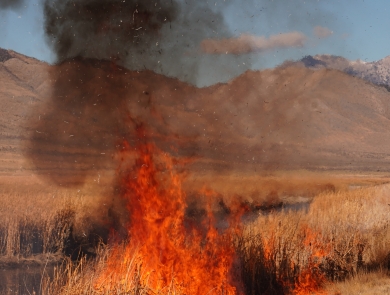Wildfires in California have become an all-too-frequent occurrence, devastating not only human communities but also displacing and injuring countless Wildlife Rescue After California Wildfires. Volunteering for wildlife rescue is a rewarding way to make a difference and help animals recover and thrive in the wake of these disasters. In this guide, we’ll explore how you can get involved and make a meaningful contribution.
Understanding the Impact of Wildfires on Wildlife
California’s Wildfire Season: A Recurring Challenge
California has faced increasingly intense wildfires in recent years. Droughts, high temperatures, and strong winds create a perfect storm for wildfires to ignite and spread rapidly. In 2023 alone, more than 4.5 million acres were burned, affecting diverse ecosystems.
Wildfires don’t just destroy forests and grasslands—they also disrupt food chains, leave animals homeless, and alter ecosystems in profound ways. With fires becoming larger and more frequent, wildlife populations are struggling to adapt.
The Consequences for Wildlife
For animals, wildfires are life-threatening events. Many are trapped or injured while fleeing flames, while others lose their habitats entirely. Small mammals, birds, Wildlife Rescue After California Wildfires reptiles, and even larger predators like deer and mountain lions often face starvation or predation after fires destroy their ecosystems.
The long-term effects are equally concerning. Species that rely on specific habitats may struggle to recover, leading to population declines or local extinctions. The urgency to assist these animals underscores the importance of volunteer rescue efforts.
Why Volunteering Matters in Wildlife Rescue
Addressing Resource Shortages
When wildfires strike, wildlife rescue organizations are often overwhelmed. They rely heavily on volunteers to expand their reach and ensure timely assistance. With limited resources, every extra set of hands can make a significant impact.
Making a Tangible Difference
As a volunteer, your efforts directly contribute to saving lives. Whether you’re rescuing an injured hawk or rehabilitating a baby raccoon, the work is immensely rewarding. Volunteers have helped release thousands of animals back into the wild, showcasing how ordinary individuals can create extraordinary outcomes.
How to Get Started as a Wildlife Rescue Volunteer
Researching Wildlife Organizations
Start by identifying reputable organizations actively involved in wildlife rescue after California wildfires. Groups like the California Wildlife Center and The Humane Society often post volunteer opportunities on their websites. Look for organizations with good reviews, clear goals, and transparency about their operations.
Volunteer Requirements and Training
Most organizations don’t require prior experience, but you’ll need a willingness to learn and a commitment to the cause. Training programs are often provided, covering topics like animal handling, first aid, and safety protocols. Some roles may have additional requirements, such as being physically fit or having a driver’s license.
Roles and Responsibilities of a Wildlife Rescue Volunteer
Field Rescue Efforts
Volunteers in the field play a vital role in locating and rescuing injured or displaced animals. This might involve hiking through burned areas, setting up traps for injured animals, or transporting them to care facilities. Safety is a top priority, and volunteers are trained to handle wildlife carefully and avoid personal risks.
Animal Rehabilitation and Care
Once animals are rescued, they require intensive care to recover. Volunteers assist with feeding, cleaning enclosures, and even administering basic medical treatments under supervision. It’s hard work, but seeing an animal regain its strength is an incredible experience.
Administrative and Fundraising Support
Not all volunteer roles involve direct contact with animals. Administrative tasks like answering calls, organizing donation drives, or managing social media campaigns are just as critical. These efforts help ensure the organization runs smoothly and can support more rescues.
Challenges and Rewards of Wildlife Rescue Volunteering
Physical and Emotional Challenges
Wildlife rescue volunteering is not without its hurdles. Physically, it can be exhausting—trekking through burned landscapes, lifting animals, and dealing with harsh weather conditions can take a toll. Emotionally, it’s equally challenging. Seeing injured or suffering animals Wildlife Rescue After California Wildfires can be heartbreaking, and not every rescue attempt ends in success.
However, proper training and emotional support from the team can help volunteers manage these difficulties. Organizations often offer counseling or debriefing sessions to help volunteers process their experiences. While it can be tough, the sense of purpose and the knowledge that you’re making a difference often outweigh the challenges.
Rewards of Volunteering
Despite the difficulties, the rewards of wildlife rescue volunteering are profound. It’s deeply fulfilling to see an injured animal recover and return to the wild. You’ll gain valuable skills, make lasting connections with like-minded people, and play a crucial role in conservation efforts.
Volunteers often describe the experience as life-changing, as it provides a unique perspective on the fragility of ecosystems and the resilience of wildlife. Knowing that your actions have contributed to saving a life is an incomparable feeling.
Long-Term Commitment to Wildlife Conservation
Becoming an Advocate for Wildlife
Volunteering is just the beginning. Many volunteers become lifelong advocates for wildlife conservation. This can involve educating others about the impact of wildfires, lobbying for stronger environmental policies, or promoting sustainable practices that reduce fire risks.
You can also use social media to share your experiences and raise awareness about the importance of wildlife rescue. By becoming a voice for those who cannot speak for themselves, you’re amplifying the impact of your efforts.
Staying Involved in Wildlife Rescue Efforts
Even after the immediate rescue work is done, there are plenty of ways to stay involved. Many organizations offer ongoing volunteer opportunities, from habitat restoration to community outreach programs. You can also participate in annual wildfire preparedness campaigns to help mitigate future disasters.
Additionally, mentoring new volunteers can be a rewarding way to pass on your knowledge and ensure that more people are equipped to help wildlife in need.
Resources for Wildlife Rescue Volunteers in California
List of Notable Wildlife Rescue Organizations
If you’re ready to get involved, here are some organizations that actively work in wildlife rescue and rehabilitation:
- California Wildlife Center
- Specializes in rescuing and rehabilitating injured, sick, or orphaned wildlife.
- The Humane Society of the United States (HSUS)
- Provides rescue and care for animals affected by disasters, including wildfires.
- Wildlife Emergency Services (WES)
- Focuses on emergency response for injured wildlife during and after natural disasters.
- Native Animal Rescue (Santa Cruz)
- Offers care and rehabilitation for wildlife in the Santa Cruz area.
- International Bird Rescue
- Specializes in rescuing and rehabilitating aquatic birds affected by wildfires and other disasters.
Essential Tools and Resources for Volunteers
To be effective in your role, it’s important to have the right tools and resources. Most organizations will provide basic supplies, but here are some items that may be helpful:
- Sturdy gloves and protective clothing.
- First aid kits for both humans and animals.
- Transportation tools like pet carriers or animal crates.
- Access to training resources, such as online courses or workshops.
- A support network of fellow volunteers for guidance and encouragement.
FAQs
1. What qualifications are needed to volunteer for wildlife rescue?
Most organizations don’t require prior experience. However, a passion for helping animals, the ability to follow instructions, and physical fitness for certain roles are essential. Training is usually provided.
2. Are there any risks involved in wildlife rescue volunteering?
Yes, risks can include handling injured or frightened animals, exposure to smoke or hazardous conditions, and emotional stress. Proper training and safety protocols minimize these risks.
3. Can I volunteer remotely for California wildlife rescue efforts?
Yes, many organizations need help with administrative tasks, fundraising, and social media outreach, which can be done remotely.
4. How can I find training programs for wildlife rescue?
Training is often provided by the organization you volunteer with. Additionally, online courses in wildlife rehabilitation and disaster response are available through organizations like the International Wildlife Rehabilitation Council (IWRC).
5. What is the best way to support wildlife rescue organizations financially?
Donating directly to reputable organizations, participating in fundraising events, or setting up recurring contributions are effective ways to support their work.
Conclusion
Volunteering for wildlife rescue after California wildfires is a powerful way to make a difference for animals in need. From providing hands-on care to raising awareness about wildfire prevention, there are countless ways to contribute. While the work can be challenging, the rewards are immense—not just for the animals you help, but also for the sense of fulfillment and connection you’ll gain.
By joining the efforts of dedicated wildlife organizations, you can play a crucial role in helping California’s wildlife recover and thrive after devastating wildfires. Your time and effort can truly save lives and pave the way for a brighter future for our planet’s ecosystems.





